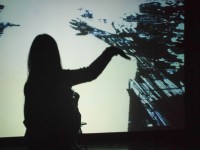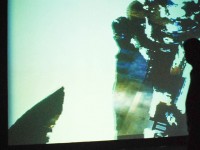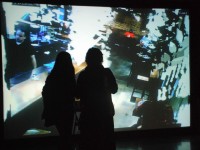GNOMONICITY
March 2012 - GNOMONICITY is an interactive digital installation, built upon security camera web-streams and the viewer's presence.
[media design] michel weber
[year] 2012
GNOMONICITY is an interactive digital installation
built upon security camera web-streams and the viewer’s presence.
The installation captures the viewers’ bodies and projects them as silhouettes through a motion-sensing process onto a white screen. It then fishes for public security camera web streams from the internet for ‘crowding’ the viewers’ silhouettes with live imagery from across the world. These web-streams are meant for private consumption, not for the virtual public domain. The two live feeds – the viewers in the gallery and the public web-streams – are collated and assembled on the screen. This makes the viewers’ presence visible through and as an aggregate of illicitly sought surveillance streams from around the world. As viewers walk in the room, their silhouettes move across the screen, revealing more of the surveillance image. At present, the installation is using 9 live streams from 5 different countries.
The visuality is offset by a recorded narration of excerpts from Italo Calvino’s novel Invisible Cities. The book explores the rendition of descriptions of cities by an explorer, Marco Polo. Brief prose poems describe 55 cities, that play on translation and imagination, wherein characters do not understand each other’s language. The narrative is overlaid on a sample of A Shepard’s Tone, an auditory illusion of a sound that continually ascends or descends in pitch, yet which ultimately seems to get no higher or lower. This note is an example of ‘self-similar’ sound, an idea innate to the title of this installation – Gnomonicity, a contemporary concept in a recent book by Gazalé, M J. for experiences of self-similarity among locations, maps and realities.
As part of Episode Two, SARAI 09; The Exhibition at Devi Art Foundation, Gurgaon, India
Created by Amitesh Grover, in collaboration with Michel Weber.




